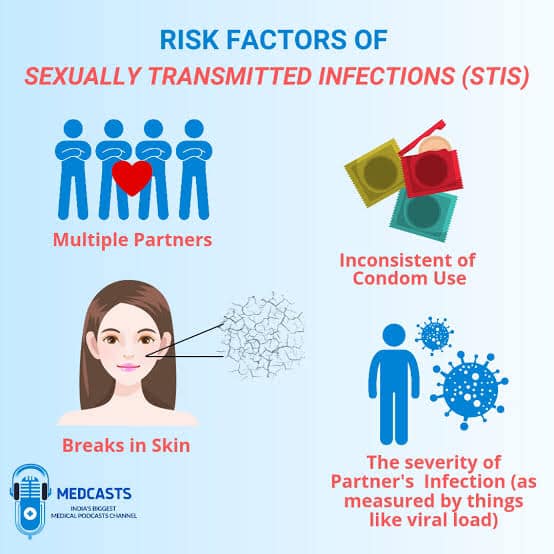Examples of sexual risk behaviors associated with exposure to a sexually transmitted infection (STI) include: (Select all that apply.)
abstinence.
multiple sex partners.
unprotected anal intercourse.
oral sex.
Correct Answer : B,C,D
Choice A reason: Abstinence is the avoidance of sexual activity, which reduces the risk of exposure to STIs. It is not a sexual risk behavior.
Choice B reason: Multiple sex partners increases the likelihood of exposure to STIs, especially if the partners are not tested or treated. It is a sexual risk behavior.
Choice C reason: Unprotected anal intercourse exposes the mucous membranes of the rectum and anus to potential pathogens, which can cause STIs such as gonorrhea, chlamydia, syphilis, and HIV. It is a sexual risk behavior.
Choice D reason: Oral sex involves contact between the mouth and the genitals or anus, which can transmit STIs such as herpes, HPV, gonorrhea, and syphilis. It is a sexual risk behavior.
Choice E reason: Dry kissing is the contact between the lips without the exchange of saliva, which does not transmit STIs. It is not a sexual risk behavior.

Nursing Test Bank
Naxlex Comprehensive Predictor Exams
Related Questions
Correct Answer is D
Explanation
Choice A reason: Maternal placenta previa is not a common complication of gestational diabetes mellitus. Placenta previa is a condition in which the placenta covers the cervix, which can cause bleeding and preterm labor. The risk factors for placenta previa include previous cesarean delivery, multiple pregnancy, advanced maternal age, and smoking.
Choice B reason: Maternal hyperemesis and neonatal low birth weight are not directly related to gestational diabetes mellitus. Hyperemesis is a severe form of nausea and vomiting during pregnancy that can cause dehydration and weight loss. The causes of hyperemesis are not well understood, but it may be influenced by hormonal changes, genetic factors, and psychological factors². Neonatal low birth weight is defined as a birth weight of less than 2,500 grams, which can be caused by many factors, such as prematurity, intrauterine growth restriction, maternal infection, and maternal malnutrition.
Choice C reason: Maternal premature rupture of membranes and neonatal sepsis are not specific to gestational diabetes mellitus. Premature rupture of membranes is a condition in which the amniotic sac breaks before labor begins, which can increase the risk of infection and preterm delivery. The causes of premature rupture of membranes are not clear, but some possible factors include infection, inflammation, stress, and trauma. Neonatal sepsis is a life-threatening infection in newborns, which can be caused by bacteria, viruses, or fungi. The risk factors for neonatal sepsis include prematurity, low birth weight, maternal infection, and invasive procedures⁵.
Choice D reason: Maternal preeclampsia and fetal macrosomia are the most common and serious complications of gestational diabetes mellitus. Preeclampsia is a condition characterized by high blood pressure and protein in the urine, which can lead to organ damage, seizures, and death. The exact cause of preeclampsia is unknown, but it may be related to abnormal placental development, immune system dysfunction, and genetic factors⁶. Fetal macrosomia is a condition in which the baby is larger than normal, usually weighing more than 4,000 grams at birth. This can cause difficulties during labor and delivery, such as shoulder dystocia, birth trauma, and cesarean section. The main cause of fetal macrosomia is excessive maternal glucose, which stimulates fetal insulin production and growth.
Correct Answer is C
Explanation
Choice A reason: Woman shorter than 62 inches or 157 cm should not restrict her weight gain during pregnancy, as she may have a higher risk of delivering a low birth weight infant. She should follow the recommended weight gain guidelines based on her pre-pregnancy body mass index (BMI).
Choice B reason: Woman in early adolescence should not restrict her weight gain during pregnancy, as she is still growing and developing herself. She may need more calories and nutrients than an adult woman to support her own health and the fetal growth.
Choice C reason: Woman who was 30 lbs overweight before pregnancy should restrict her weight gain during pregnancy, as she may have a higher risk of developing gestational diabetes, hypertension, or preeclampsia. She should aim for a lower weight gain range than a woman with a normal BMI.
Choice D reason: Woman pregnant with twins should not restrict her weight gain during pregnancy, as she needs more energy and nutrients to support the growth of two fetuses. She should aim for a higher weight gain range than a woman with a singleton pregnancy.
Whether you are a student looking to ace your exams or a practicing nurse seeking to enhance your expertise , our nursing education contents will empower you with the confidence and competence to make a difference in the lives of patients and become a respected leader in the healthcare field.
Visit Naxlex, invest in your future and unlock endless possibilities with our unparalleled nursing education contents today
Report Wrong Answer on the Current Question
Do you disagree with the answer? If yes, what is your expected answer? Explain.
Kindly be descriptive with the issue you are facing.
